STRM042 Critical Issues in Business: Leadership & Employee Retention
VerifiedAdded on 2023/06/11
|13
|4078
|59
Literature Review
AI Summary
This literature review examines the critical issues of leadership and employee retention in the age of uncertainty, focusing on the impact of leadership on employee engagement. It highlights the differences between leadership and management, emphasizing the importance of leaders in motivating and retaining talented employees. The review discusses the role of organizational culture in executing business strategies and fostering employee engagement through various leadership styles, including McGregor's Theory X and Y. Factors impacting employee engagement, such as career growth opportunities and networking, are also explored. The review concludes by stressing the significance of employee engagement in achieving organizational goals, particularly in uncertain economic climates.
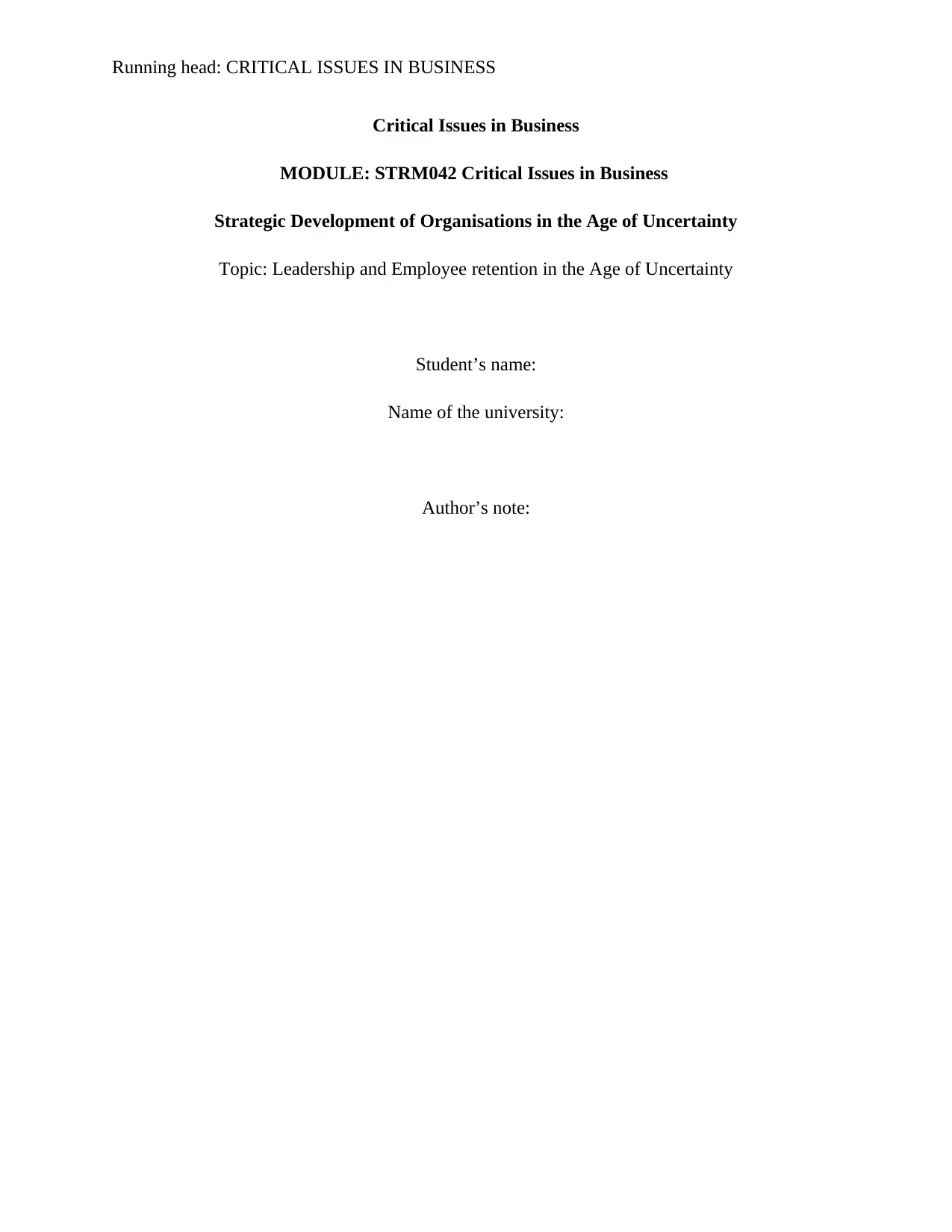
Running head: CRITICAL ISSUES IN BUSINESS
Critical Issues in Business
MODULE: STRM042 Critical Issues in Business
Strategic Development of Organisations in the Age of Uncertainty
Topic: Leadership and Employee retention in the Age of Uncertainty
Student’s name:
Name of the university:
Author’s note:
Critical Issues in Business
MODULE: STRM042 Critical Issues in Business
Strategic Development of Organisations in the Age of Uncertainty
Topic: Leadership and Employee retention in the Age of Uncertainty
Student’s name:
Name of the university:
Author’s note:
Paraphrase This Document
Need a fresh take? Get an instant paraphrase of this document with our AI Paraphraser
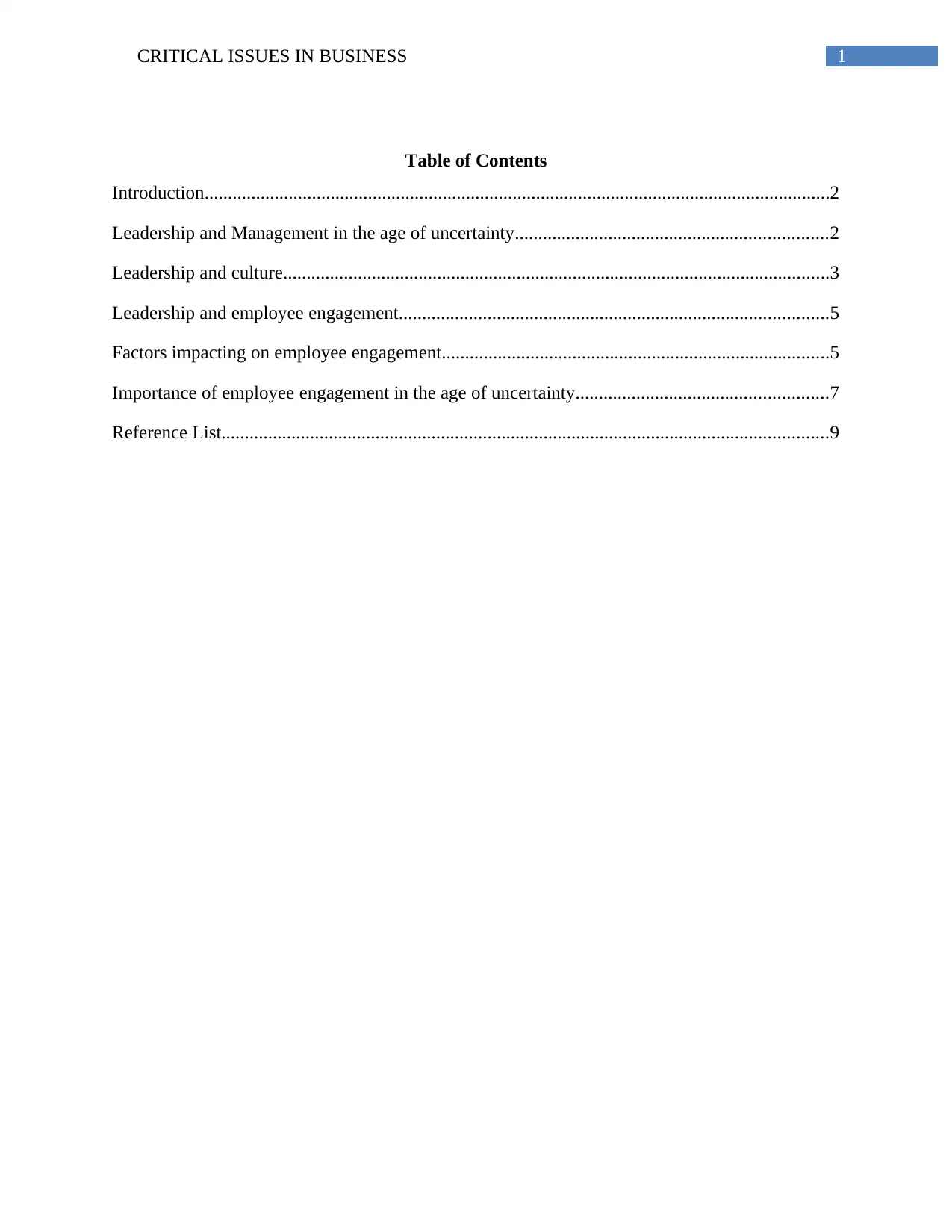
1CRITICAL ISSUES IN BUSINESS
Table of Contents
Introduction......................................................................................................................................2
Leadership and Management in the age of uncertainty...................................................................2
Leadership and culture.....................................................................................................................3
Leadership and employee engagement............................................................................................5
Factors impacting on employee engagement...................................................................................5
Importance of employee engagement in the age of uncertainty......................................................7
Reference List..................................................................................................................................9
Table of Contents
Introduction......................................................................................................................................2
Leadership and Management in the age of uncertainty...................................................................2
Leadership and culture.....................................................................................................................3
Leadership and employee engagement............................................................................................5
Factors impacting on employee engagement...................................................................................5
Importance of employee engagement in the age of uncertainty......................................................7
Reference List..................................................................................................................................9
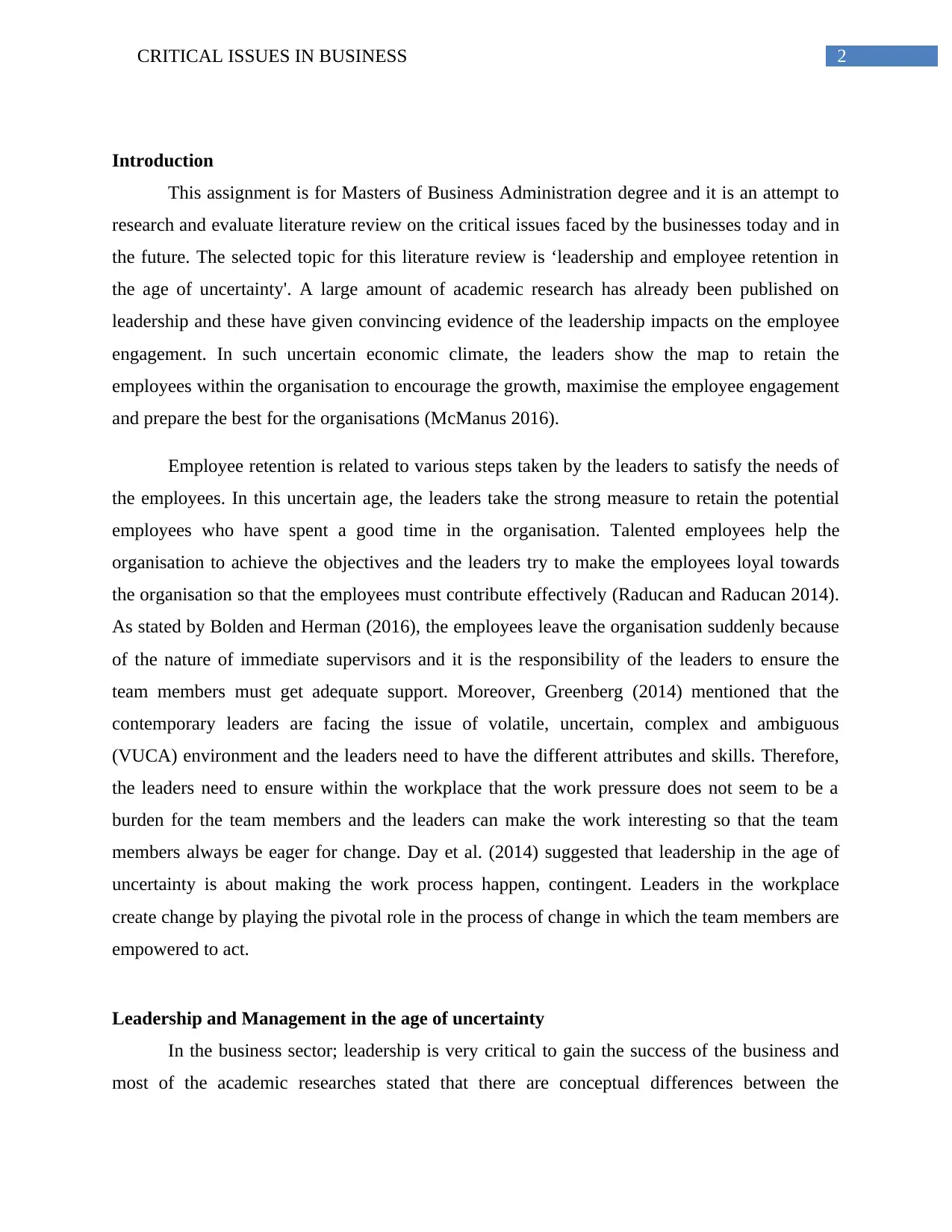
2CRITICAL ISSUES IN BUSINESS
Introduction
This assignment is for Masters of Business Administration degree and it is an attempt to
research and evaluate literature review on the critical issues faced by the businesses today and in
the future. The selected topic for this literature review is ‘leadership and employee retention in
the age of uncertainty'. A large amount of academic research has already been published on
leadership and these have given convincing evidence of the leadership impacts on the employee
engagement. In such uncertain economic climate, the leaders show the map to retain the
employees within the organisation to encourage the growth, maximise the employee engagement
and prepare the best for the organisations (McManus 2016).
Employee retention is related to various steps taken by the leaders to satisfy the needs of
the employees. In this uncertain age, the leaders take the strong measure to retain the potential
employees who have spent a good time in the organisation. Talented employees help the
organisation to achieve the objectives and the leaders try to make the employees loyal towards
the organisation so that the employees must contribute effectively (Raducan and Raducan 2014).
As stated by Bolden and Herman (2016), the employees leave the organisation suddenly because
of the nature of immediate supervisors and it is the responsibility of the leaders to ensure the
team members must get adequate support. Moreover, Greenberg (2014) mentioned that the
contemporary leaders are facing the issue of volatile, uncertain, complex and ambiguous
(VUCA) environment and the leaders need to have the different attributes and skills. Therefore,
the leaders need to ensure within the workplace that the work pressure does not seem to be a
burden for the team members and the leaders can make the work interesting so that the team
members always be eager for change. Day et al. (2014) suggested that leadership in the age of
uncertainty is about making the work process happen, contingent. Leaders in the workplace
create change by playing the pivotal role in the process of change in which the team members are
empowered to act.
Leadership and Management in the age of uncertainty
In the business sector; leadership is very critical to gain the success of the business and
most of the academic researches stated that there are conceptual differences between the
Introduction
This assignment is for Masters of Business Administration degree and it is an attempt to
research and evaluate literature review on the critical issues faced by the businesses today and in
the future. The selected topic for this literature review is ‘leadership and employee retention in
the age of uncertainty'. A large amount of academic research has already been published on
leadership and these have given convincing evidence of the leadership impacts on the employee
engagement. In such uncertain economic climate, the leaders show the map to retain the
employees within the organisation to encourage the growth, maximise the employee engagement
and prepare the best for the organisations (McManus 2016).
Employee retention is related to various steps taken by the leaders to satisfy the needs of
the employees. In this uncertain age, the leaders take the strong measure to retain the potential
employees who have spent a good time in the organisation. Talented employees help the
organisation to achieve the objectives and the leaders try to make the employees loyal towards
the organisation so that the employees must contribute effectively (Raducan and Raducan 2014).
As stated by Bolden and Herman (2016), the employees leave the organisation suddenly because
of the nature of immediate supervisors and it is the responsibility of the leaders to ensure the
team members must get adequate support. Moreover, Greenberg (2014) mentioned that the
contemporary leaders are facing the issue of volatile, uncertain, complex and ambiguous
(VUCA) environment and the leaders need to have the different attributes and skills. Therefore,
the leaders need to ensure within the workplace that the work pressure does not seem to be a
burden for the team members and the leaders can make the work interesting so that the team
members always be eager for change. Day et al. (2014) suggested that leadership in the age of
uncertainty is about making the work process happen, contingent. Leaders in the workplace
create change by playing the pivotal role in the process of change in which the team members are
empowered to act.
Leadership and Management in the age of uncertainty
In the business sector; leadership is very critical to gain the success of the business and
most of the academic researches stated that there are conceptual differences between the
⊘ This is a preview!⊘
Do you want full access?
Subscribe today to unlock all pages.

Trusted by 1+ million students worldwide
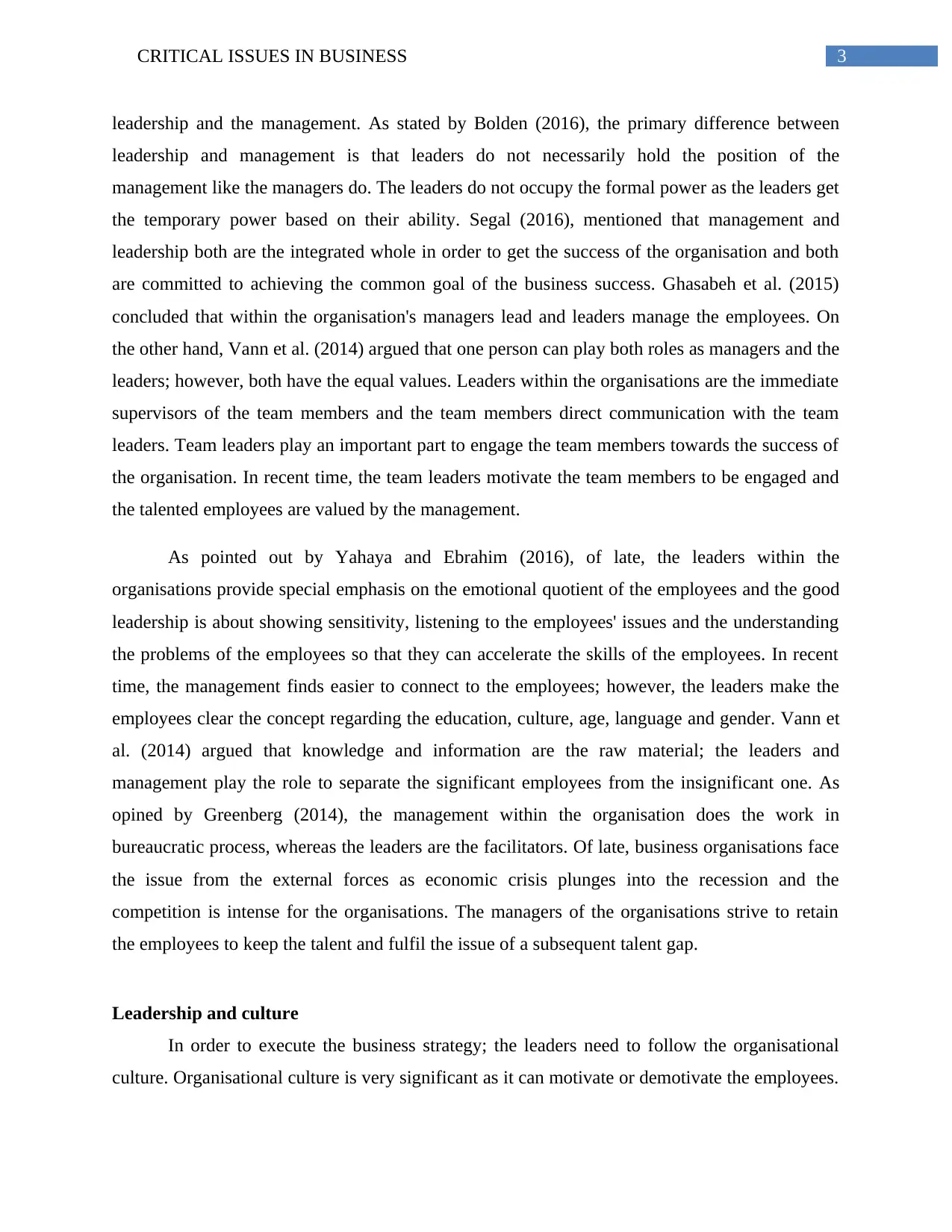
3CRITICAL ISSUES IN BUSINESS
leadership and the management. As stated by Bolden (2016), the primary difference between
leadership and management is that leaders do not necessarily hold the position of the
management like the managers do. The leaders do not occupy the formal power as the leaders get
the temporary power based on their ability. Segal (2016), mentioned that management and
leadership both are the integrated whole in order to get the success of the organisation and both
are committed to achieving the common goal of the business success. Ghasabeh et al. (2015)
concluded that within the organisation's managers lead and leaders manage the employees. On
the other hand, Vann et al. (2014) argued that one person can play both roles as managers and the
leaders; however, both have the equal values. Leaders within the organisations are the immediate
supervisors of the team members and the team members direct communication with the team
leaders. Team leaders play an important part to engage the team members towards the success of
the organisation. In recent time, the team leaders motivate the team members to be engaged and
the talented employees are valued by the management.
As pointed out by Yahaya and Ebrahim (2016), of late, the leaders within the
organisations provide special emphasis on the emotional quotient of the employees and the good
leadership is about showing sensitivity, listening to the employees' issues and the understanding
the problems of the employees so that they can accelerate the skills of the employees. In recent
time, the management finds easier to connect to the employees; however, the leaders make the
employees clear the concept regarding the education, culture, age, language and gender. Vann et
al. (2014) argued that knowledge and information are the raw material; the leaders and
management play the role to separate the significant employees from the insignificant one. As
opined by Greenberg (2014), the management within the organisation does the work in
bureaucratic process, whereas the leaders are the facilitators. Of late, business organisations face
the issue from the external forces as economic crisis plunges into the recession and the
competition is intense for the organisations. The managers of the organisations strive to retain
the employees to keep the talent and fulfil the issue of a subsequent talent gap.
Leadership and culture
In order to execute the business strategy; the leaders need to follow the organisational
culture. Organisational culture is very significant as it can motivate or demotivate the employees.
leadership and the management. As stated by Bolden (2016), the primary difference between
leadership and management is that leaders do not necessarily hold the position of the
management like the managers do. The leaders do not occupy the formal power as the leaders get
the temporary power based on their ability. Segal (2016), mentioned that management and
leadership both are the integrated whole in order to get the success of the organisation and both
are committed to achieving the common goal of the business success. Ghasabeh et al. (2015)
concluded that within the organisation's managers lead and leaders manage the employees. On
the other hand, Vann et al. (2014) argued that one person can play both roles as managers and the
leaders; however, both have the equal values. Leaders within the organisations are the immediate
supervisors of the team members and the team members direct communication with the team
leaders. Team leaders play an important part to engage the team members towards the success of
the organisation. In recent time, the team leaders motivate the team members to be engaged and
the talented employees are valued by the management.
As pointed out by Yahaya and Ebrahim (2016), of late, the leaders within the
organisations provide special emphasis on the emotional quotient of the employees and the good
leadership is about showing sensitivity, listening to the employees' issues and the understanding
the problems of the employees so that they can accelerate the skills of the employees. In recent
time, the management finds easier to connect to the employees; however, the leaders make the
employees clear the concept regarding the education, culture, age, language and gender. Vann et
al. (2014) argued that knowledge and information are the raw material; the leaders and
management play the role to separate the significant employees from the insignificant one. As
opined by Greenberg (2014), the management within the organisation does the work in
bureaucratic process, whereas the leaders are the facilitators. Of late, business organisations face
the issue from the external forces as economic crisis plunges into the recession and the
competition is intense for the organisations. The managers of the organisations strive to retain
the employees to keep the talent and fulfil the issue of a subsequent talent gap.
Leadership and culture
In order to execute the business strategy; the leaders need to follow the organisational
culture. Organisational culture is very significant as it can motivate or demotivate the employees.
Paraphrase This Document
Need a fresh take? Get an instant paraphrase of this document with our AI Paraphraser
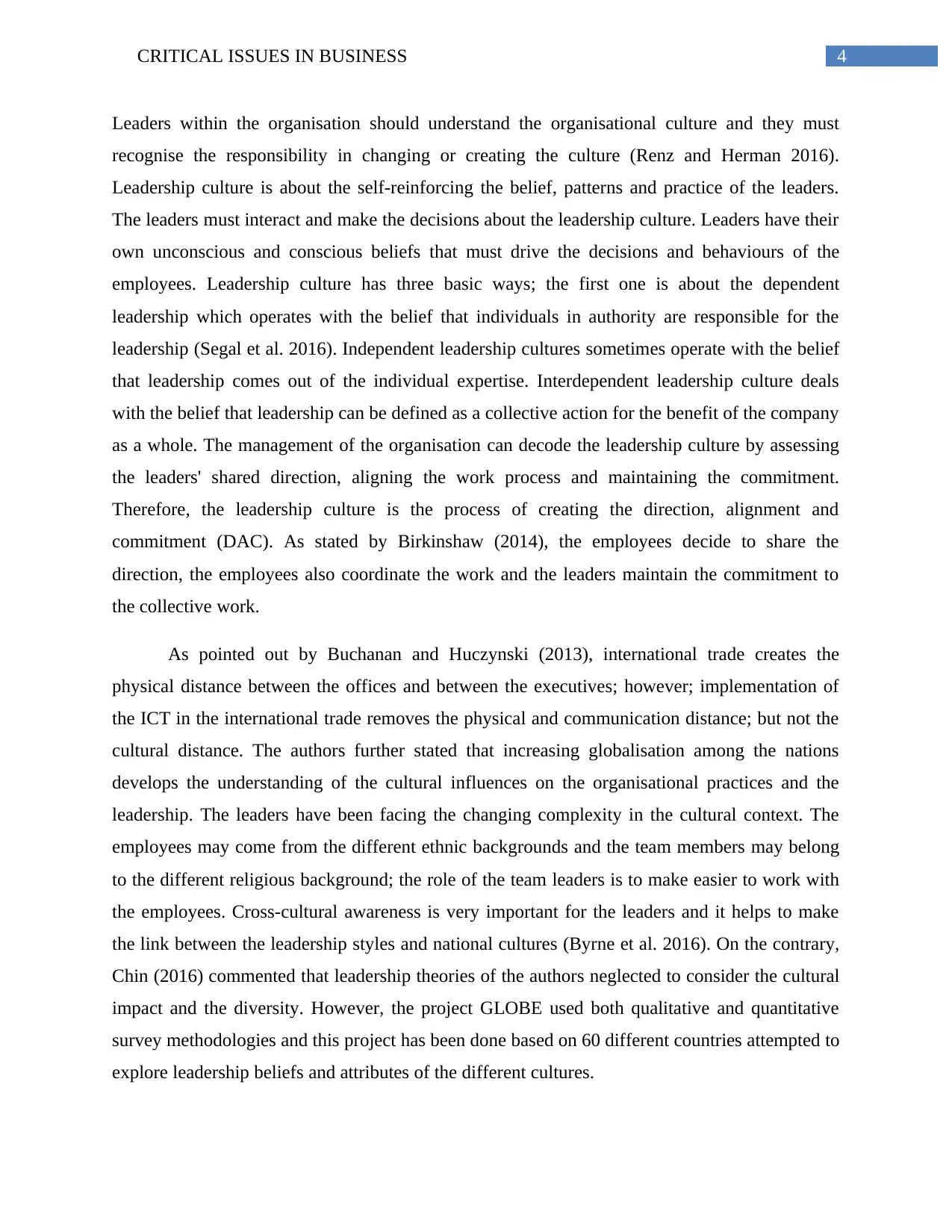
4CRITICAL ISSUES IN BUSINESS
Leaders within the organisation should understand the organisational culture and they must
recognise the responsibility in changing or creating the culture (Renz and Herman 2016).
Leadership culture is about the self-reinforcing the belief, patterns and practice of the leaders.
The leaders must interact and make the decisions about the leadership culture. Leaders have their
own unconscious and conscious beliefs that must drive the decisions and behaviours of the
employees. Leadership culture has three basic ways; the first one is about the dependent
leadership which operates with the belief that individuals in authority are responsible for the
leadership (Segal et al. 2016). Independent leadership cultures sometimes operate with the belief
that leadership comes out of the individual expertise. Interdependent leadership culture deals
with the belief that leadership can be defined as a collective action for the benefit of the company
as a whole. The management of the organisation can decode the leadership culture by assessing
the leaders' shared direction, aligning the work process and maintaining the commitment.
Therefore, the leadership culture is the process of creating the direction, alignment and
commitment (DAC). As stated by Birkinshaw (2014), the employees decide to share the
direction, the employees also coordinate the work and the leaders maintain the commitment to
the collective work.
As pointed out by Buchanan and Huczynski (2013), international trade creates the
physical distance between the offices and between the executives; however; implementation of
the ICT in the international trade removes the physical and communication distance; but not the
cultural distance. The authors further stated that increasing globalisation among the nations
develops the understanding of the cultural influences on the organisational practices and the
leadership. The leaders have been facing the changing complexity in the cultural context. The
employees may come from the different ethnic backgrounds and the team members may belong
to the different religious background; the role of the team leaders is to make easier to work with
the employees. Cross-cultural awareness is very important for the leaders and it helps to make
the link between the leadership styles and national cultures (Byrne et al. 2016). On the contrary,
Chin (2016) commented that leadership theories of the authors neglected to consider the cultural
impact and the diversity. However, the project GLOBE used both qualitative and quantitative
survey methodologies and this project has been done based on 60 different countries attempted to
explore leadership beliefs and attributes of the different cultures.
Leaders within the organisation should understand the organisational culture and they must
recognise the responsibility in changing or creating the culture (Renz and Herman 2016).
Leadership culture is about the self-reinforcing the belief, patterns and practice of the leaders.
The leaders must interact and make the decisions about the leadership culture. Leaders have their
own unconscious and conscious beliefs that must drive the decisions and behaviours of the
employees. Leadership culture has three basic ways; the first one is about the dependent
leadership which operates with the belief that individuals in authority are responsible for the
leadership (Segal et al. 2016). Independent leadership cultures sometimes operate with the belief
that leadership comes out of the individual expertise. Interdependent leadership culture deals
with the belief that leadership can be defined as a collective action for the benefit of the company
as a whole. The management of the organisation can decode the leadership culture by assessing
the leaders' shared direction, aligning the work process and maintaining the commitment.
Therefore, the leadership culture is the process of creating the direction, alignment and
commitment (DAC). As stated by Birkinshaw (2014), the employees decide to share the
direction, the employees also coordinate the work and the leaders maintain the commitment to
the collective work.
As pointed out by Buchanan and Huczynski (2013), international trade creates the
physical distance between the offices and between the executives; however; implementation of
the ICT in the international trade removes the physical and communication distance; but not the
cultural distance. The authors further stated that increasing globalisation among the nations
develops the understanding of the cultural influences on the organisational practices and the
leadership. The leaders have been facing the changing complexity in the cultural context. The
employees may come from the different ethnic backgrounds and the team members may belong
to the different religious background; the role of the team leaders is to make easier to work with
the employees. Cross-cultural awareness is very important for the leaders and it helps to make
the link between the leadership styles and national cultures (Byrne et al. 2016). On the contrary,
Chin (2016) commented that leadership theories of the authors neglected to consider the cultural
impact and the diversity. However, the project GLOBE used both qualitative and quantitative
survey methodologies and this project has been done based on 60 different countries attempted to
explore leadership beliefs and attributes of the different cultures.
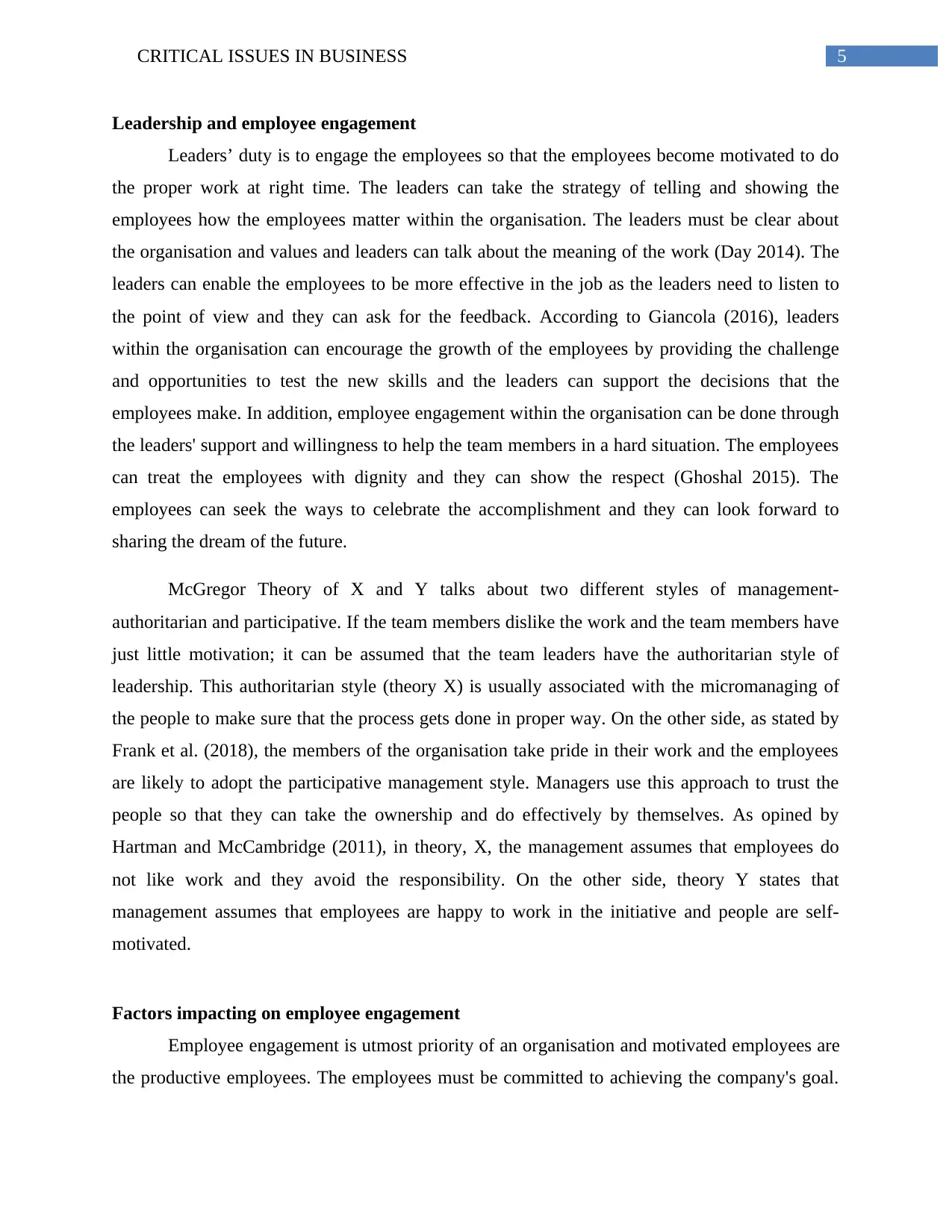
5CRITICAL ISSUES IN BUSINESS
Leadership and employee engagement
Leaders’ duty is to engage the employees so that the employees become motivated to do
the proper work at right time. The leaders can take the strategy of telling and showing the
employees how the employees matter within the organisation. The leaders must be clear about
the organisation and values and leaders can talk about the meaning of the work (Day 2014). The
leaders can enable the employees to be more effective in the job as the leaders need to listen to
the point of view and they can ask for the feedback. According to Giancola (2016), leaders
within the organisation can encourage the growth of the employees by providing the challenge
and opportunities to test the new skills and the leaders can support the decisions that the
employees make. In addition, employee engagement within the organisation can be done through
the leaders' support and willingness to help the team members in a hard situation. The employees
can treat the employees with dignity and they can show the respect (Ghoshal 2015). The
employees can seek the ways to celebrate the accomplishment and they can look forward to
sharing the dream of the future.
McGregor Theory of X and Y talks about two different styles of management-
authoritarian and participative. If the team members dislike the work and the team members have
just little motivation; it can be assumed that the team leaders have the authoritarian style of
leadership. This authoritarian style (theory X) is usually associated with the micromanaging of
the people to make sure that the process gets done in proper way. On the other side, as stated by
Frank et al. (2018), the members of the organisation take pride in their work and the employees
are likely to adopt the participative management style. Managers use this approach to trust the
people so that they can take the ownership and do effectively by themselves. As opined by
Hartman and McCambridge (2011), in theory, X, the management assumes that employees do
not like work and they avoid the responsibility. On the other side, theory Y states that
management assumes that employees are happy to work in the initiative and people are self-
motivated.
Factors impacting on employee engagement
Employee engagement is utmost priority of an organisation and motivated employees are
the productive employees. The employees must be committed to achieving the company's goal.
Leadership and employee engagement
Leaders’ duty is to engage the employees so that the employees become motivated to do
the proper work at right time. The leaders can take the strategy of telling and showing the
employees how the employees matter within the organisation. The leaders must be clear about
the organisation and values and leaders can talk about the meaning of the work (Day 2014). The
leaders can enable the employees to be more effective in the job as the leaders need to listen to
the point of view and they can ask for the feedback. According to Giancola (2016), leaders
within the organisation can encourage the growth of the employees by providing the challenge
and opportunities to test the new skills and the leaders can support the decisions that the
employees make. In addition, employee engagement within the organisation can be done through
the leaders' support and willingness to help the team members in a hard situation. The employees
can treat the employees with dignity and they can show the respect (Ghoshal 2015). The
employees can seek the ways to celebrate the accomplishment and they can look forward to
sharing the dream of the future.
McGregor Theory of X and Y talks about two different styles of management-
authoritarian and participative. If the team members dislike the work and the team members have
just little motivation; it can be assumed that the team leaders have the authoritarian style of
leadership. This authoritarian style (theory X) is usually associated with the micromanaging of
the people to make sure that the process gets done in proper way. On the other side, as stated by
Frank et al. (2018), the members of the organisation take pride in their work and the employees
are likely to adopt the participative management style. Managers use this approach to trust the
people so that they can take the ownership and do effectively by themselves. As opined by
Hartman and McCambridge (2011), in theory, X, the management assumes that employees do
not like work and they avoid the responsibility. On the other side, theory Y states that
management assumes that employees are happy to work in the initiative and people are self-
motivated.
Factors impacting on employee engagement
Employee engagement is utmost priority of an organisation and motivated employees are
the productive employees. The employees must be committed to achieving the company's goal.
⊘ This is a preview!⊘
Do you want full access?
Subscribe today to unlock all pages.

Trusted by 1+ million students worldwide
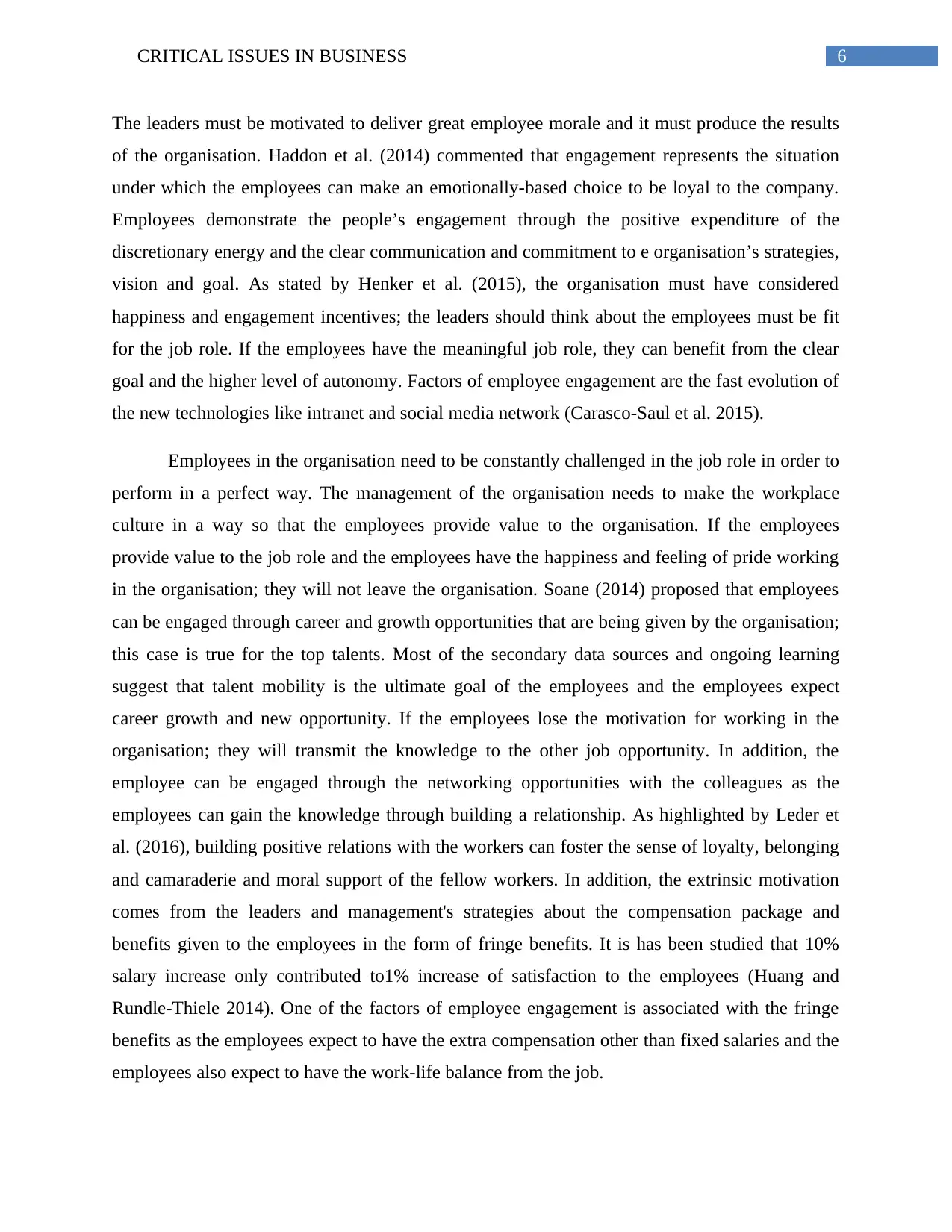
6CRITICAL ISSUES IN BUSINESS
The leaders must be motivated to deliver great employee morale and it must produce the results
of the organisation. Haddon et al. (2014) commented that engagement represents the situation
under which the employees can make an emotionally-based choice to be loyal to the company.
Employees demonstrate the people’s engagement through the positive expenditure of the
discretionary energy and the clear communication and commitment to e organisation’s strategies,
vision and goal. As stated by Henker et al. (2015), the organisation must have considered
happiness and engagement incentives; the leaders should think about the employees must be fit
for the job role. If the employees have the meaningful job role, they can benefit from the clear
goal and the higher level of autonomy. Factors of employee engagement are the fast evolution of
the new technologies like intranet and social media network (Carasco-Saul et al. 2015).
Employees in the organisation need to be constantly challenged in the job role in order to
perform in a perfect way. The management of the organisation needs to make the workplace
culture in a way so that the employees provide value to the organisation. If the employees
provide value to the job role and the employees have the happiness and feeling of pride working
in the organisation; they will not leave the organisation. Soane (2014) proposed that employees
can be engaged through career and growth opportunities that are being given by the organisation;
this case is true for the top talents. Most of the secondary data sources and ongoing learning
suggest that talent mobility is the ultimate goal of the employees and the employees expect
career growth and new opportunity. If the employees lose the motivation for working in the
organisation; they will transmit the knowledge to the other job opportunity. In addition, the
employee can be engaged through the networking opportunities with the colleagues as the
employees can gain the knowledge through building a relationship. As highlighted by Leder et
al. (2016), building positive relations with the workers can foster the sense of loyalty, belonging
and camaraderie and moral support of the fellow workers. In addition, the extrinsic motivation
comes from the leaders and management's strategies about the compensation package and
benefits given to the employees in the form of fringe benefits. It is has been studied that 10%
salary increase only contributed to1% increase of satisfaction to the employees (Huang and
Rundle-Thiele 2014). One of the factors of employee engagement is associated with the fringe
benefits as the employees expect to have the extra compensation other than fixed salaries and the
employees also expect to have the work-life balance from the job.
The leaders must be motivated to deliver great employee morale and it must produce the results
of the organisation. Haddon et al. (2014) commented that engagement represents the situation
under which the employees can make an emotionally-based choice to be loyal to the company.
Employees demonstrate the people’s engagement through the positive expenditure of the
discretionary energy and the clear communication and commitment to e organisation’s strategies,
vision and goal. As stated by Henker et al. (2015), the organisation must have considered
happiness and engagement incentives; the leaders should think about the employees must be fit
for the job role. If the employees have the meaningful job role, they can benefit from the clear
goal and the higher level of autonomy. Factors of employee engagement are the fast evolution of
the new technologies like intranet and social media network (Carasco-Saul et al. 2015).
Employees in the organisation need to be constantly challenged in the job role in order to
perform in a perfect way. The management of the organisation needs to make the workplace
culture in a way so that the employees provide value to the organisation. If the employees
provide value to the job role and the employees have the happiness and feeling of pride working
in the organisation; they will not leave the organisation. Soane (2014) proposed that employees
can be engaged through career and growth opportunities that are being given by the organisation;
this case is true for the top talents. Most of the secondary data sources and ongoing learning
suggest that talent mobility is the ultimate goal of the employees and the employees expect
career growth and new opportunity. If the employees lose the motivation for working in the
organisation; they will transmit the knowledge to the other job opportunity. In addition, the
employee can be engaged through the networking opportunities with the colleagues as the
employees can gain the knowledge through building a relationship. As highlighted by Leder et
al. (2016), building positive relations with the workers can foster the sense of loyalty, belonging
and camaraderie and moral support of the fellow workers. In addition, the extrinsic motivation
comes from the leaders and management's strategies about the compensation package and
benefits given to the employees in the form of fringe benefits. It is has been studied that 10%
salary increase only contributed to1% increase of satisfaction to the employees (Huang and
Rundle-Thiele 2014). One of the factors of employee engagement is associated with the fringe
benefits as the employees expect to have the extra compensation other than fixed salaries and the
employees also expect to have the work-life balance from the job.
Paraphrase This Document
Need a fresh take? Get an instant paraphrase of this document with our AI Paraphraser
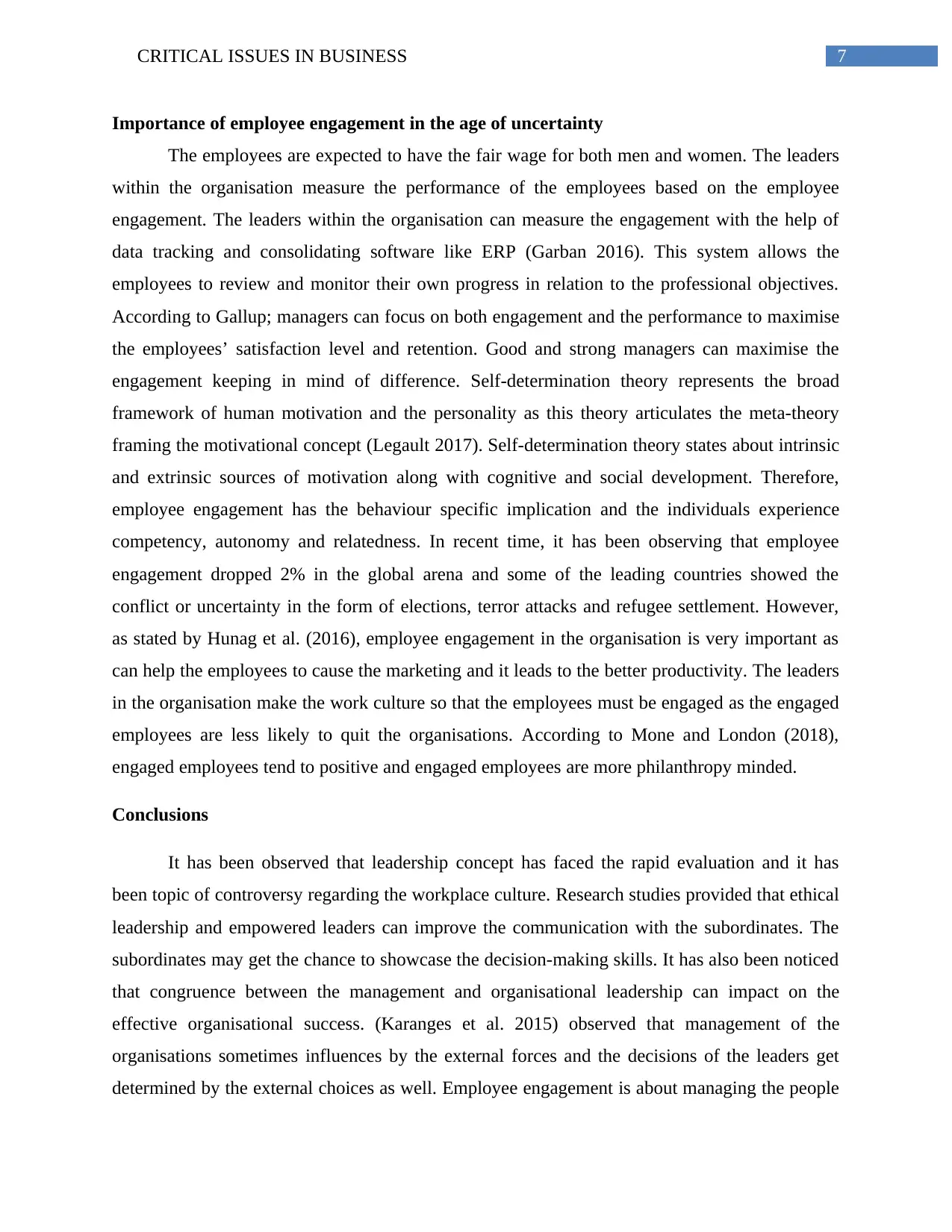
7CRITICAL ISSUES IN BUSINESS
Importance of employee engagement in the age of uncertainty
The employees are expected to have the fair wage for both men and women. The leaders
within the organisation measure the performance of the employees based on the employee
engagement. The leaders within the organisation can measure the engagement with the help of
data tracking and consolidating software like ERP (Garban 2016). This system allows the
employees to review and monitor their own progress in relation to the professional objectives.
According to Gallup; managers can focus on both engagement and the performance to maximise
the employees’ satisfaction level and retention. Good and strong managers can maximise the
engagement keeping in mind of difference. Self-determination theory represents the broad
framework of human motivation and the personality as this theory articulates the meta-theory
framing the motivational concept (Legault 2017). Self-determination theory states about intrinsic
and extrinsic sources of motivation along with cognitive and social development. Therefore,
employee engagement has the behaviour specific implication and the individuals experience
competency, autonomy and relatedness. In recent time, it has been observing that employee
engagement dropped 2% in the global arena and some of the leading countries showed the
conflict or uncertainty in the form of elections, terror attacks and refugee settlement. However,
as stated by Hunag et al. (2016), employee engagement in the organisation is very important as
can help the employees to cause the marketing and it leads to the better productivity. The leaders
in the organisation make the work culture so that the employees must be engaged as the engaged
employees are less likely to quit the organisations. According to Mone and London (2018),
engaged employees tend to positive and engaged employees are more philanthropy minded.
Conclusions
It has been observed that leadership concept has faced the rapid evaluation and it has
been topic of controversy regarding the workplace culture. Research studies provided that ethical
leadership and empowered leaders can improve the communication with the subordinates. The
subordinates may get the chance to showcase the decision-making skills. It has also been noticed
that congruence between the management and organisational leadership can impact on the
effective organisational success. (Karanges et al. 2015) observed that management of the
organisations sometimes influences by the external forces and the decisions of the leaders get
determined by the external choices as well. Employee engagement is about managing the people
Importance of employee engagement in the age of uncertainty
The employees are expected to have the fair wage for both men and women. The leaders
within the organisation measure the performance of the employees based on the employee
engagement. The leaders within the organisation can measure the engagement with the help of
data tracking and consolidating software like ERP (Garban 2016). This system allows the
employees to review and monitor their own progress in relation to the professional objectives.
According to Gallup; managers can focus on both engagement and the performance to maximise
the employees’ satisfaction level and retention. Good and strong managers can maximise the
engagement keeping in mind of difference. Self-determination theory represents the broad
framework of human motivation and the personality as this theory articulates the meta-theory
framing the motivational concept (Legault 2017). Self-determination theory states about intrinsic
and extrinsic sources of motivation along with cognitive and social development. Therefore,
employee engagement has the behaviour specific implication and the individuals experience
competency, autonomy and relatedness. In recent time, it has been observing that employee
engagement dropped 2% in the global arena and some of the leading countries showed the
conflict or uncertainty in the form of elections, terror attacks and refugee settlement. However,
as stated by Hunag et al. (2016), employee engagement in the organisation is very important as
can help the employees to cause the marketing and it leads to the better productivity. The leaders
in the organisation make the work culture so that the employees must be engaged as the engaged
employees are less likely to quit the organisations. According to Mone and London (2018),
engaged employees tend to positive and engaged employees are more philanthropy minded.
Conclusions
It has been observed that leadership concept has faced the rapid evaluation and it has
been topic of controversy regarding the workplace culture. Research studies provided that ethical
leadership and empowered leaders can improve the communication with the subordinates. The
subordinates may get the chance to showcase the decision-making skills. It has also been noticed
that congruence between the management and organisational leadership can impact on the
effective organisational success. (Karanges et al. 2015) observed that management of the
organisations sometimes influences by the external forces and the decisions of the leaders get
determined by the external choices as well. Employee engagement is about managing the people
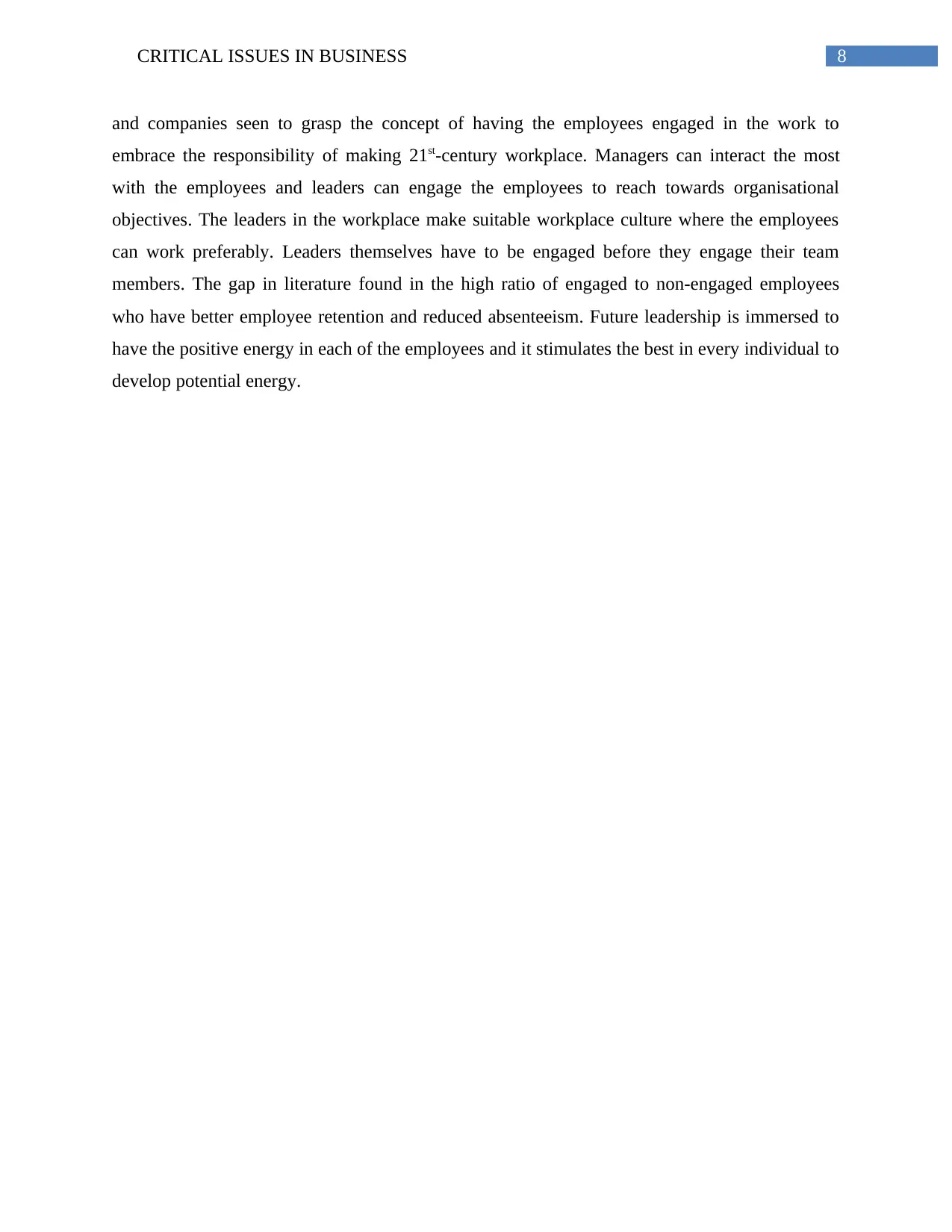
8CRITICAL ISSUES IN BUSINESS
and companies seen to grasp the concept of having the employees engaged in the work to
embrace the responsibility of making 21st-century workplace. Managers can interact the most
with the employees and leaders can engage the employees to reach towards organisational
objectives. The leaders in the workplace make suitable workplace culture where the employees
can work preferably. Leaders themselves have to be engaged before they engage their team
members. The gap in literature found in the high ratio of engaged to non-engaged employees
who have better employee retention and reduced absenteeism. Future leadership is immersed to
have the positive energy in each of the employees and it stimulates the best in every individual to
develop potential energy.
and companies seen to grasp the concept of having the employees engaged in the work to
embrace the responsibility of making 21st-century workplace. Managers can interact the most
with the employees and leaders can engage the employees to reach towards organisational
objectives. The leaders in the workplace make suitable workplace culture where the employees
can work preferably. Leaders themselves have to be engaged before they engage their team
members. The gap in literature found in the high ratio of engaged to non-engaged employees
who have better employee retention and reduced absenteeism. Future leadership is immersed to
have the positive energy in each of the employees and it stimulates the best in every individual to
develop potential energy.
⊘ This is a preview!⊘
Do you want full access?
Subscribe today to unlock all pages.

Trusted by 1+ million students worldwide
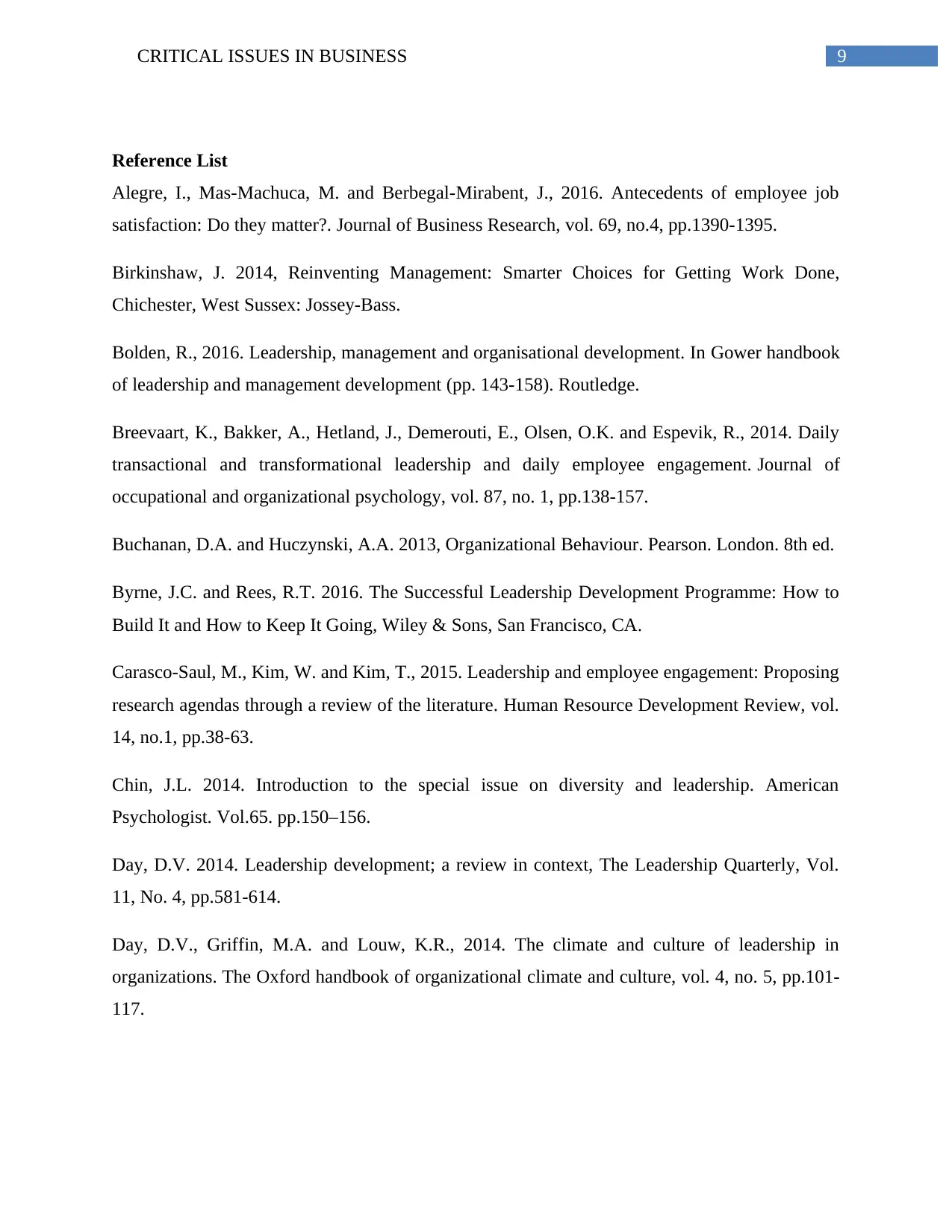
9CRITICAL ISSUES IN BUSINESS
Reference List
Alegre, I., Mas-Machuca, M. and Berbegal-Mirabent, J., 2016. Antecedents of employee job
satisfaction: Do they matter?. Journal of Business Research, vol. 69, no.4, pp.1390-1395.
Birkinshaw, J. 2014, Reinventing Management: Smarter Choices for Getting Work Done,
Chichester, West Sussex: Jossey-Bass.
Bolden, R., 2016. Leadership, management and organisational development. In Gower handbook
of leadership and management development (pp. 143-158). Routledge.
Breevaart, K., Bakker, A., Hetland, J., Demerouti, E., Olsen, O.K. and Espevik, R., 2014. Daily
transactional and transformational leadership and daily employee engagement. Journal of
occupational and organizational psychology, vol. 87, no. 1, pp.138-157.
Buchanan, D.A. and Huczynski, A.A. 2013, Organizational Behaviour. Pearson. London. 8th ed.
Byrne, J.C. and Rees, R.T. 2016. The Successful Leadership Development Programme: How to
Build It and How to Keep It Going, Wiley & Sons, San Francisco, CA.
Carasco-Saul, M., Kim, W. and Kim, T., 2015. Leadership and employee engagement: Proposing
research agendas through a review of the literature. Human Resource Development Review, vol.
14, no.1, pp.38-63.
Chin, J.L. 2014. Introduction to the special issue on diversity and leadership. American
Psychologist. Vol.65. pp.150–156.
Day, D.V. 2014. Leadership development; a review in context, The Leadership Quarterly, Vol.
11, No. 4, pp.581-614.
Day, D.V., Griffin, M.A. and Louw, K.R., 2014. The climate and culture of leadership in
organizations. The Oxford handbook of organizational climate and culture, vol. 4, no. 5, pp.101-
117.
Reference List
Alegre, I., Mas-Machuca, M. and Berbegal-Mirabent, J., 2016. Antecedents of employee job
satisfaction: Do they matter?. Journal of Business Research, vol. 69, no.4, pp.1390-1395.
Birkinshaw, J. 2014, Reinventing Management: Smarter Choices for Getting Work Done,
Chichester, West Sussex: Jossey-Bass.
Bolden, R., 2016. Leadership, management and organisational development. In Gower handbook
of leadership and management development (pp. 143-158). Routledge.
Breevaart, K., Bakker, A., Hetland, J., Demerouti, E., Olsen, O.K. and Espevik, R., 2014. Daily
transactional and transformational leadership and daily employee engagement. Journal of
occupational and organizational psychology, vol. 87, no. 1, pp.138-157.
Buchanan, D.A. and Huczynski, A.A. 2013, Organizational Behaviour. Pearson. London. 8th ed.
Byrne, J.C. and Rees, R.T. 2016. The Successful Leadership Development Programme: How to
Build It and How to Keep It Going, Wiley & Sons, San Francisco, CA.
Carasco-Saul, M., Kim, W. and Kim, T., 2015. Leadership and employee engagement: Proposing
research agendas through a review of the literature. Human Resource Development Review, vol.
14, no.1, pp.38-63.
Chin, J.L. 2014. Introduction to the special issue on diversity and leadership. American
Psychologist. Vol.65. pp.150–156.
Day, D.V. 2014. Leadership development; a review in context, The Leadership Quarterly, Vol.
11, No. 4, pp.581-614.
Day, D.V., Griffin, M.A. and Louw, K.R., 2014. The climate and culture of leadership in
organizations. The Oxford handbook of organizational climate and culture, vol. 4, no. 5, pp.101-
117.
Paraphrase This Document
Need a fresh take? Get an instant paraphrase of this document with our AI Paraphraser
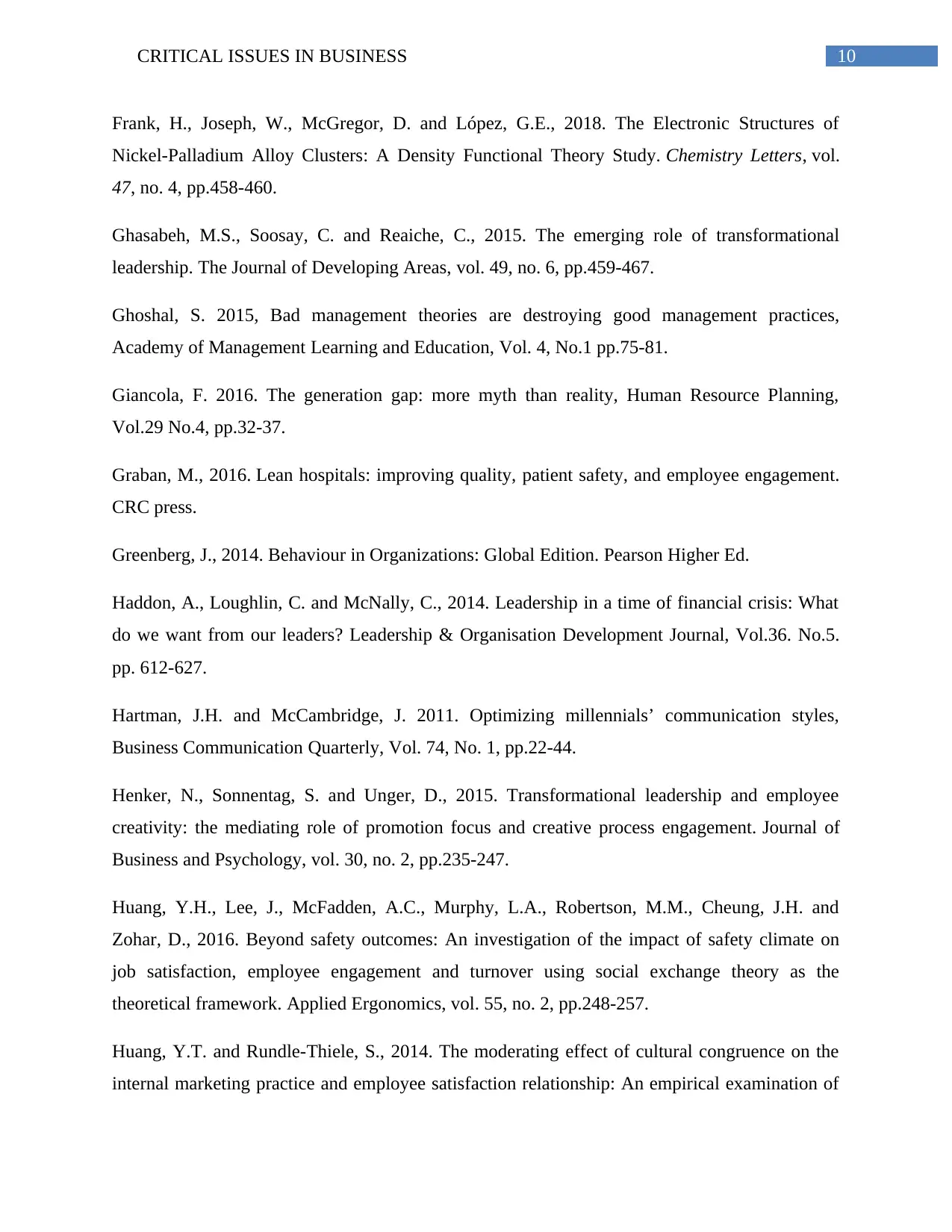
10CRITICAL ISSUES IN BUSINESS
Frank, H., Joseph, W., McGregor, D. and López, G.E., 2018. The Electronic Structures of
Nickel-Palladium Alloy Clusters: A Density Functional Theory Study. Chemistry Letters, vol.
47, no. 4, pp.458-460.
Ghasabeh, M.S., Soosay, C. and Reaiche, C., 2015. The emerging role of transformational
leadership. The Journal of Developing Areas, vol. 49, no. 6, pp.459-467.
Ghoshal, S. 2015, Bad management theories are destroying good management practices,
Academy of Management Learning and Education, Vol. 4, No.1 pp.75-81.
Giancola, F. 2016. The generation gap: more myth than reality, Human Resource Planning,
Vol.29 No.4, pp.32-37.
Graban, M., 2016. Lean hospitals: improving quality, patient safety, and employee engagement.
CRC press.
Greenberg, J., 2014. Behaviour in Organizations: Global Edition. Pearson Higher Ed.
Haddon, A., Loughlin, C. and McNally, C., 2014. Leadership in a time of financial crisis: What
do we want from our leaders? Leadership & Organisation Development Journal, Vol.36. No.5.
pp. 612-627.
Hartman, J.H. and McCambridge, J. 2011. Optimizing millennials’ communication styles,
Business Communication Quarterly, Vol. 74, No. 1, pp.22-44.
Henker, N., Sonnentag, S. and Unger, D., 2015. Transformational leadership and employee
creativity: the mediating role of promotion focus and creative process engagement. Journal of
Business and Psychology, vol. 30, no. 2, pp.235-247.
Huang, Y.H., Lee, J., McFadden, A.C., Murphy, L.A., Robertson, M.M., Cheung, J.H. and
Zohar, D., 2016. Beyond safety outcomes: An investigation of the impact of safety climate on
job satisfaction, employee engagement and turnover using social exchange theory as the
theoretical framework. Applied Ergonomics, vol. 55, no. 2, pp.248-257.
Huang, Y.T. and Rundle-Thiele, S., 2014. The moderating effect of cultural congruence on the
internal marketing practice and employee satisfaction relationship: An empirical examination of
Frank, H., Joseph, W., McGregor, D. and López, G.E., 2018. The Electronic Structures of
Nickel-Palladium Alloy Clusters: A Density Functional Theory Study. Chemistry Letters, vol.
47, no. 4, pp.458-460.
Ghasabeh, M.S., Soosay, C. and Reaiche, C., 2015. The emerging role of transformational
leadership. The Journal of Developing Areas, vol. 49, no. 6, pp.459-467.
Ghoshal, S. 2015, Bad management theories are destroying good management practices,
Academy of Management Learning and Education, Vol. 4, No.1 pp.75-81.
Giancola, F. 2016. The generation gap: more myth than reality, Human Resource Planning,
Vol.29 No.4, pp.32-37.
Graban, M., 2016. Lean hospitals: improving quality, patient safety, and employee engagement.
CRC press.
Greenberg, J., 2014. Behaviour in Organizations: Global Edition. Pearson Higher Ed.
Haddon, A., Loughlin, C. and McNally, C., 2014. Leadership in a time of financial crisis: What
do we want from our leaders? Leadership & Organisation Development Journal, Vol.36. No.5.
pp. 612-627.
Hartman, J.H. and McCambridge, J. 2011. Optimizing millennials’ communication styles,
Business Communication Quarterly, Vol. 74, No. 1, pp.22-44.
Henker, N., Sonnentag, S. and Unger, D., 2015. Transformational leadership and employee
creativity: the mediating role of promotion focus and creative process engagement. Journal of
Business and Psychology, vol. 30, no. 2, pp.235-247.
Huang, Y.H., Lee, J., McFadden, A.C., Murphy, L.A., Robertson, M.M., Cheung, J.H. and
Zohar, D., 2016. Beyond safety outcomes: An investigation of the impact of safety climate on
job satisfaction, employee engagement and turnover using social exchange theory as the
theoretical framework. Applied Ergonomics, vol. 55, no. 2, pp.248-257.
Huang, Y.T. and Rundle-Thiele, S., 2014. The moderating effect of cultural congruence on the
internal marketing practice and employee satisfaction relationship: An empirical examination of
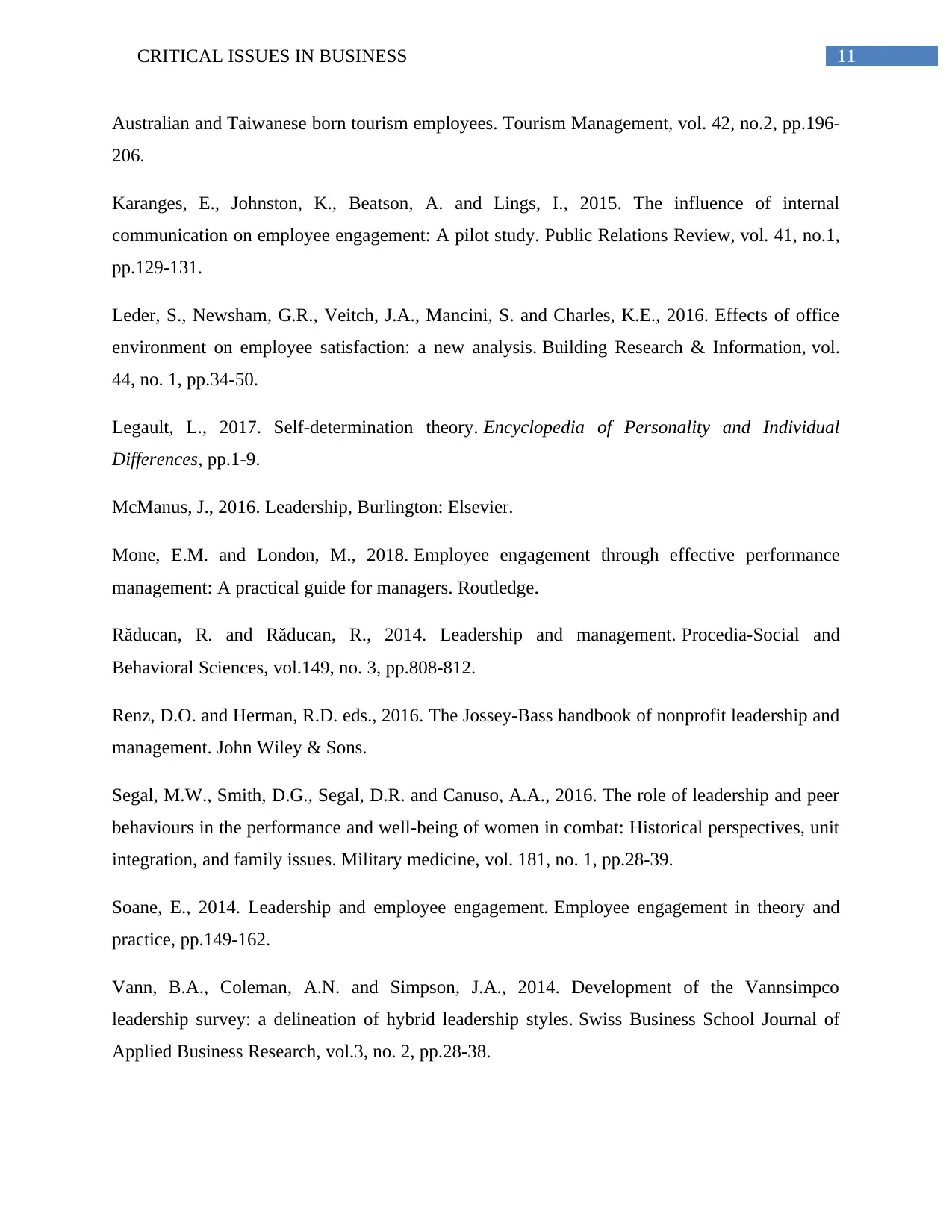
11CRITICAL ISSUES IN BUSINESS
Australian and Taiwanese born tourism employees. Tourism Management, vol. 42, no.2, pp.196-
206.
Karanges, E., Johnston, K., Beatson, A. and Lings, I., 2015. The influence of internal
communication on employee engagement: A pilot study. Public Relations Review, vol. 41, no.1,
pp.129-131.
Leder, S., Newsham, G.R., Veitch, J.A., Mancini, S. and Charles, K.E., 2016. Effects of office
environment on employee satisfaction: a new analysis. Building Research & Information, vol.
44, no. 1, pp.34-50.
Legault, L., 2017. Self-determination theory. Encyclopedia of Personality and Individual
Differences, pp.1-9.
McManus, J., 2016. Leadership, Burlington: Elsevier.
Mone, E.M. and London, M., 2018. Employee engagement through effective performance
management: A practical guide for managers. Routledge.
Răducan, R. and Răducan, R., 2014. Leadership and management. Procedia-Social and
Behavioral Sciences, vol.149, no. 3, pp.808-812.
Renz, D.O. and Herman, R.D. eds., 2016. The Jossey-Bass handbook of nonprofit leadership and
management. John Wiley & Sons.
Segal, M.W., Smith, D.G., Segal, D.R. and Canuso, A.A., 2016. The role of leadership and peer
behaviours in the performance and well-being of women in combat: Historical perspectives, unit
integration, and family issues. Military medicine, vol. 181, no. 1, pp.28-39.
Soane, E., 2014. Leadership and employee engagement. Employee engagement in theory and
practice, pp.149-162.
Vann, B.A., Coleman, A.N. and Simpson, J.A., 2014. Development of the Vannsimpco
leadership survey: a delineation of hybrid leadership styles. Swiss Business School Journal of
Applied Business Research, vol.3, no. 2, pp.28-38.
Australian and Taiwanese born tourism employees. Tourism Management, vol. 42, no.2, pp.196-
206.
Karanges, E., Johnston, K., Beatson, A. and Lings, I., 2015. The influence of internal
communication on employee engagement: A pilot study. Public Relations Review, vol. 41, no.1,
pp.129-131.
Leder, S., Newsham, G.R., Veitch, J.A., Mancini, S. and Charles, K.E., 2016. Effects of office
environment on employee satisfaction: a new analysis. Building Research & Information, vol.
44, no. 1, pp.34-50.
Legault, L., 2017. Self-determination theory. Encyclopedia of Personality and Individual
Differences, pp.1-9.
McManus, J., 2016. Leadership, Burlington: Elsevier.
Mone, E.M. and London, M., 2018. Employee engagement through effective performance
management: A practical guide for managers. Routledge.
Răducan, R. and Răducan, R., 2014. Leadership and management. Procedia-Social and
Behavioral Sciences, vol.149, no. 3, pp.808-812.
Renz, D.O. and Herman, R.D. eds., 2016. The Jossey-Bass handbook of nonprofit leadership and
management. John Wiley & Sons.
Segal, M.W., Smith, D.G., Segal, D.R. and Canuso, A.A., 2016. The role of leadership and peer
behaviours in the performance and well-being of women in combat: Historical perspectives, unit
integration, and family issues. Military medicine, vol. 181, no. 1, pp.28-39.
Soane, E., 2014. Leadership and employee engagement. Employee engagement in theory and
practice, pp.149-162.
Vann, B.A., Coleman, A.N. and Simpson, J.A., 2014. Development of the Vannsimpco
leadership survey: a delineation of hybrid leadership styles. Swiss Business School Journal of
Applied Business Research, vol.3, no. 2, pp.28-38.
⊘ This is a preview!⊘
Do you want full access?
Subscribe today to unlock all pages.

Trusted by 1+ million students worldwide
1 out of 13
Related Documents
Your All-in-One AI-Powered Toolkit for Academic Success.
+13062052269
info@desklib.com
Available 24*7 on WhatsApp / Email
![[object Object]](/_next/static/media/star-bottom.7253800d.svg)
Unlock your academic potential
Copyright © 2020–2025 A2Z Services. All Rights Reserved. Developed and managed by ZUCOL.





